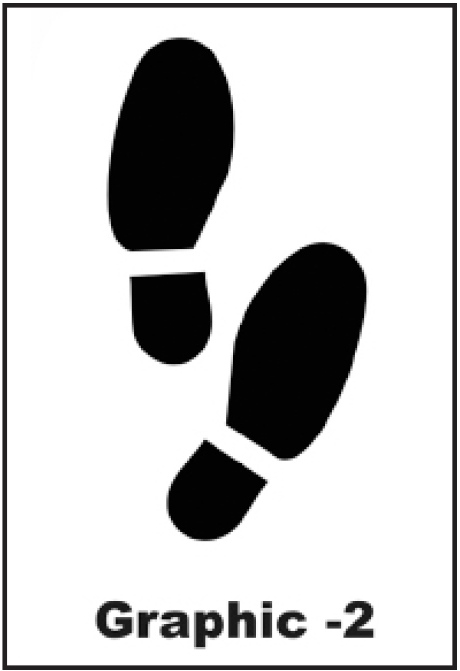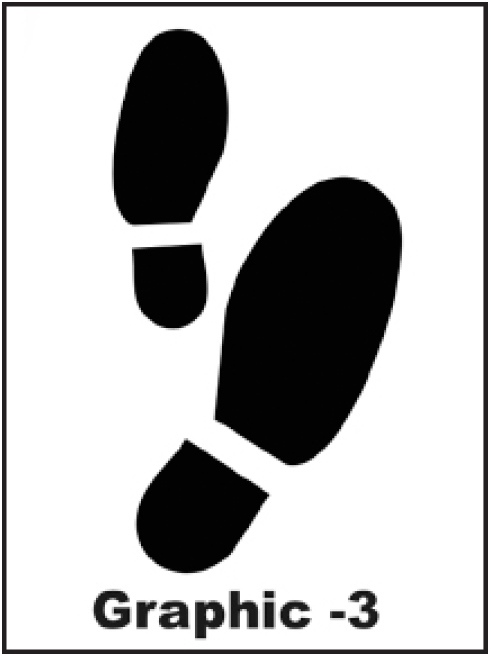Sometimes when bowlers are in a slump or they just need something to get them to the next level, it only takes a small adjustment or change to make a big difference. In this article, I am continuing from the February 2013 BTM a list of things I know have made noticeable differences in people’s games. Some of them are things that people just don’t think of very often, if at all.
Nothing seems to work for everyone, so work your way through the list and see if any of these help you. Keep in mind that something that didn’t work two years ago may, in fact, work for you today.
Foot placement and weight distribution
How you stand and distribute your weight is a small change that can make a significant difference in your shotmaking ability. If you look at the footprint graphics, you will see the stance I prefer most of the time. This was created for a righthanded bowler so a lefthander will have to reverse, as usual.
Graphic 1 shows you how to get the feet in proper alignment. You will notice that the heel of the left foot fits nicely into the arch of the right foot. Once you get your feet in the position shown in Graphic 1, slide the right foot back a few inches until it is comfortable as shown in Graphic 2. I like the left foot pointing in the direction you intend to walk. Get that foot settled first then move the right foot back into position. Play around with the placement a little to find the positions you are most comfortable using.
I like this starting position for two reasons. One, you are stable in a full 360 degree circle. If someone were to give you a little push in any direction you would still be stable. If you stand with your feet side by side, you are pretty stable left and right, but it takes very little effort to push you backward or forward.
I know that bowling is not a contact sport and your opponents are not trying to push you off balance, but if you are not stable from the start of the approach it can lead to inconsistent shotmaking. The other bad thing about starting with your feet side-by-side is that you have to shift all your weight to the foot you are not going to move before you can take a step. This starts your weight rocking left and right and makes you wobble like a duck.
If you take four steps, you can divide your weight equally between the two feet or slightly to the back foot. Then, when you shift all your weight to the front foot (left foot), your weight is not being transferred side to side, but mostly front to back. This eliminates the duck walk right away.
If you take five steps, try shifting most of your weight to the back foot (right foot). This is shown in Graphic 3 by the back foot being larger than the front foot as it is carrying most of the weight. To start a five-step approach, simply remove all the weight from the forward foot lifting it ever so slightly off the floor and push off with the back foot.
This will propel your left foot forward. As your weight shifts forward, the left foot will land in not only the proper spot, but the same spot each time. This will help eliminate the growing first step which I will cover next.
No matter how you produce your first step from this standing position, all the motion is front to back and not side to side, avoiding the duck walk.
The growing first step
It has been my experience that first steps tend to grow in size for a lot of bowlers. When the first step gets too big, it starts a chain of bad reactions. Most bowlers tend to end up the same distance from the foul line no matter how large the first step grows. This forces the other steps to be subconsciously shortened. Now the gait of the footwork no longer synchronizes with the armswing, throwing the timing and everything else off.
It seems to me that the first step starts growing when the bowler has been bowling really well. I think it happens simply out of enthusiasm. When we are striking a lot we almost can’t wait to get up there and throw the ball again. I think that enthusiasm makes the first step grow, but that is just a guess on my part. Ironically, an unintended lengthening of the first step can bring an end to our hot streak and we may never know why. Unless we really pay attention to it, we can’t feel the first step grow larger and, since we usually end up the same distance from the foul line, we don’t get a clue from that either.
I suggest when you are bowling really well, have someone check the length of your first step for you or shoot a video on your own. Then you will have a resource for when your first step is the proper length and a reference to check the next time you are bowling poorly.
While it has been my experience that a growing first step affects most bowlers, some actually start taking too short a first step. This usually happens when the bowler has been bowling under par for his game or bowling on a really difficult lane condition.
The culprit here is just trying to be too careful with each shot. Don’t be careful and don’t sneak up on the pins. If you do either, your gait will never match your armswing properly. Come out of the gate like you mean business and just let it flow.
Heads up
I am sure most of us old movie buffs have seen scenes where an etiquette instructor was teaching a young girl to walk with good posture and asked her to walk with a book balanced on her head to keep her head steady. Now I am not asking you to bowl with a book on your head, but just pretending it is up there seems to help a lot.
A lot of bowlers drop their head down or bend too far at the waist, and at the wrong time. More often than not bowlers who drop their head down too much during the approach can be spotted popping their heads back up at the foul line.
I could write pages on the effects of posture on the swing, leverage, and shot repetition, but I am just offering a list of things to try. Just try bowling a game or two pretending there is a book balanced on top of your head so you can keep your head steady all the way through the approach. I use this one a lot and it has helped a lot of bowlers smooth out their approach.
Look pretty at the foul line
Even those of us with the ugliest mugs (that means face to you young people) can look pretty at the foul line. That means a deep knee bend if we are capable, our nose over our toes and not beyond. Our trail leg is down, we are not falling all over the approach, and we are not popping up at the foul line like a jack-in-the-box.
If you are not sure what “pretty” looks like at the foul line, do a quick YouTube search for David Ozio or Sean Rash if you are righthanded, Eric Forkel or Parker Bohn if you are lefthanded. Each of these champion players is stable as a rock every time they deliver the ball. Even though Ozio and Forkel have been retired from the national tour for a few years, they still look the same today when they throw the ball as they did 15 years ago.
I know that some BTM readers are very keen observers and they are thinking to themselves about now…what about Walter Ray Williams? He is not as “pretty” at the foul line as those guys and he is a pretty good player.
As I have said many times, nothing works for everyone and, given the chance to work with Mr. Williams, I would not suggest he try to look like David Ozio when he throws the ball. I would, however, not hesitate one second to tell Mr. Williams to go look like Walter Ray Williams at the foul line when he is throwing his best shot if he was in a slump and having trouble repeating shots.
Not all the guys on tour look pretty at the foul line, but they do look the same shot after shot, which brings me to my final tip of the series. Simply tell yourself to focus on one thing and one thing only. Look pretty at the foul line. You will be amazed sometimes how well you will throw the ball when your only goal is to look pretty at the foul line.
You see, you have to do most things during the approach correctly in order to actually end up correctly at the foul line. If you try to think of all the individual parts it takes to make a great approach, one part at the time, you will mess them up. By just telling yourself to only concentrate on looking good at the end you are tricking yourself into throwing a good shot. Give it a try. Believe me, it works.





